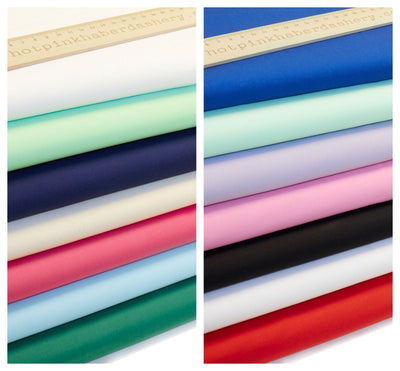How to makes your own Roman Blinds
Although we don’t really want to think about it just yet, unfortunately the summer of a lifetime (actually a British summer with sun!) is coming to a close. We’re hoping and praying that the weather will pick back up over September but we’re safe guarding just in case…
Once the temperature starts to drop, the nights are longer and the days shorter, it’s important to ensure that your windows are covered to keep in the warmth and block out the dark skies outside. If you have any windows that are currently in need of new blinds, or perhaps just need a spruce in time for Autumn, we have just the guide for you..!
Unlike standard curtains and blinds, Roman blinds a very smooth and streamlined silhouette that can be adjusted to only allow the desired amount of light into a room. Roman blinds are classic, contemporary and don’t require a huge amount of skill or extra equipment! Below, we’ve outlined how to make your own gorgeous roman blinds in several easy steps:

Step 1 - Wood cutting
Get your hands on some 1x1 wood that should fit across the inside top of the window opening. screw the 1x1 to the window frame - be warned that you cannot inside-mount on French doors!
Step 2 - Select your fabric! (our favourite bit…)
We recommend that you use cotton fabric for your Roman blinds as it’s light weight and you will have a lot of options to pick from to suit your decor perfectly. You want fabric that is light, sturdy and can be cleaned if necessary. Blinds can be a big feature in a room, so also be sure to pick fabric that suits the room they’re in and the vibe you’re trying to achieve
Step 3 - Cutting the fabric
Add an inch in both height and width to the size of the window open, to allow for seams. The outer fabric can be cut a little bit wider so that it wraps around each side, sort of like a margin, on the back side of the blind. This will help to give it a more professional look as well as being tidy with strong edges. You can cut the fabric with fabric scissors - cotton gives easily!
Step 4 - Getting your layers together
Once you have your correctly sized pieces of fabric, you need to pin them together. First of all, ensure that the right sides are facing each other (the side with the print!). At this point, you may want to sew fabric tape to the lining of the fabric to make channels for inserting the battens rather than gluing them
Step 5 - Sew around the perimeter
Here, ensure you leave several inches open to allow for turning the fabric the right way round when finished. Cut off the seam allowances you’ve made at the corners so that it will turn cleanly and won’t bunch up in the corner! If the outer fabric is wider in order to create a margin on the back, just sew the sides together. You now need to hem the bottom by hand and use iron-on hem tape along the top as that part won’t be seen

Step 6 - Turn the fabric the right side out and iron it flat
When you iron, make sure to take extra care that the front of the fabric covers the lining fabric at the edges so that the lining fabric doesn’t show - it doesn’t look very neat and tidy!
Step 7 - Slip stitch the opening…
Now it’s time to close up the opening! Sew a strip of velcro across the top of the edge of the material; this will later be used to attach the fabric to the wood!
Step 8 - Measure and mark the horizontal lines
Find your horizontal lines and mark where you want the horizontal pleats/folds to fall. Be sure to glue the ‘battens’ or your choice of thin strips of stiffening material horizontally across your fabric at the pleat marks. You can also unpick the seams at the sides of the fabric and slide he battens between the layers to hide them if you really want. Whilst it’s not 100% necessary to use battens, you may find that your blind pleats will sag without them making them look quite sad!
Step 9 - Wait for the glue to dry
The glue should take around 20 minutes to dry, unless of course you have stitched pockets for the battens to slide into by sewing parallel lines across the blinds at your pleat marks
Step 10 - Sew plastic loops to the battens
Make sure your loops are spaced evenly in at least two vertical lines - ensure these are fastened really securely to avoid any disappointment or need for maintenance later on!

Step 11 - Measure and cut two lengths of cord
Your cord should be twice height of the window. Tie your cords securely to the bottom loop on each vertical line of loops, then thread the cords vertically through the sewn-on loops. Next, insert a screw-eye bolt to the 1x1 at each point where the vertical lines touch it
Step 12 - Attach the blinds to the wood!
You can either use velcro or staples to secure the top of your blinds to the wood
Step 13 - Thread your cord
Here, you need to thread your cord through the eye bolt, keeping the fabric laying flat before running each of the cords through their own screw-eye at the top. Run all cords through all screw eyes at the top to being them all over to one side which will be used for raising and lowering the blinds. Next, knot the cords together just beyond the last screw-eye and arrange the fabric to fall in neat folds - if needs be, use an iron here. Pull the cord gently and ensure the fabric falls in neat folds; again, use an iron again if you wish!
Step 14 - Keep your blinds neat!
Finally, make sure your fold lines are clean and neat - battens should do the job for you. After all of this has been done, you should have some perfect roman blinds hanging to be super proud of!







Leave a comment